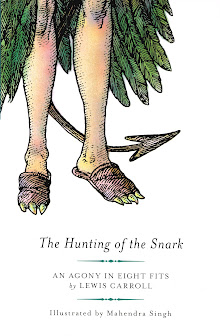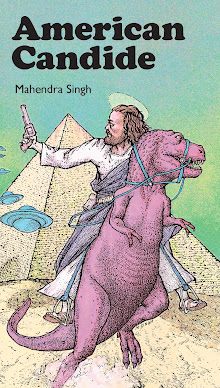
THE HUNTING OF THE SNARK by Lewis Carroll, a graphic novel by this artist and explained here, page by page, panel by panel … right now we're in Fit the Sixth, where the Barrister (played by Martin Heidegger) is dreaming of prosecuting a pig …
If you’ve been assiduously following our nonsensical res publica, The Hunting of the Snark, you might have noticed that there has been a steady accumulation of visual details as the story progresses. Such a gradual amplification of things is what the critics call fritter-my-wig or even what-you-may-call-um and believe me, it’s all the rage in the right sort of literary circles.
However, we ‘umble visual artists, (fixated as always on more alimentary matters) call such an accumulation of visual tchotchkes "chicken fat". The late, great Will Elder coined the term whilst inking a drowned fly into a late night rendering of Harvey Kurtzman’s matzoh-ball soup as a practical joke. After a bit of the usual overheated vaudeville cross-talk-cum-haberule®-brandishing and some soft-shoeing with the Pro-White on Elder’s part, the moniker stuck and generations of artists have been ladling the chicken fat (or even schmalz if it’s germane to the proceedings) into their more soup-like drawings ever since.
All of which is a very convoluted and uselessly byzantine way of saying that you should keep a close eye on the progression of our Snark Hunt for it’s growing ever richer in unsaturated animal lipids such as chicken fat and Martin Heidegger. Naturally, one wonders what Lewis Carroll would have made of all our messing about with his otherwise perfectly normal recipe for a bowl of soup … would he have smacked his lips appreciatively at the our addition of the accurately-besmocked and bestyed pigherder Witnesses demonstrating the swineless vacuity of this comic operetta of a legal farce? Would he have slurped greedily at the tasty bits of the timeless humour of Mister Piggy’s magnum opus hoisted aloft before the proceedings like some sort of philosophical pearls before swine?
Or would Mister Carroll have paused in mid-luncheon, his spoon poised at his lips, and angrily demanded this artist to explain post haste what this other bird, this nonchicken and perhaps even swan-like bird masquerading as a legal bagpipe is doing in our collation of a Snark Hunt?
Alas, for Mr. Carroll and his delicate Victorian sense and sensibilities! This unexpectedly swannish creature is probably the grotesque and unexpected consequence of this artist using second-grade-fresh chicken fat in his cheapster drawings, a fly-by-night chicken fat cunningly adulterated with etymological preservatives of unknown provenance.
Yes, dear reader, this sudden outbreak of swans and bagpipes is no accident, on the contrary, it is a Significant Detail! Curiously, the word "sound", deriving as it does from the Old English word "swan," (properly, the sounding bird) seems to provide a perfect excuse for this artist to wreak further havoc on the entire chicken fat paradigm and perhaps even clear the way for a future swan-fat thing-um-a-jig. Or something along these metaphorically miscegenated lines of reasoning which so bedevil this production of the Snark …
Without error or flaw indeed, eh?








A delightful illustration and explication!
ReplyDeleteI feel constrained to point out though that "sound" doesn't actually *derive* from "swan". Rather they are *cognate*, relatives.
"Sound" comes into English through Anglo-Norman "soun" (cp. Old French "son"). The "-d" is a later, 'excrescent' development, similar to that of modern English "thunder" (the word in Old English is "þunor" with no "-d-"; cp. Old Norse "þórr", a component of our "Thursday"). The OED mentions the disdain of certain 16th-century prescriptivists for this excrescent "d": '...The form with excrescent -d finally established itself in the 16th cent., but is condemned by Stanyhurst as late as 1582 (Æneid To Reader, p. 11)...'
"Swan", on the other hand, is a Teutonic word, rather than an import like "soun(d)". Both "sound" (through French, ultimately from Latin) and "swan" can, however, be traced back to the same Proto-Indo-European root, "*swen-" 'to sound, to make noise'; whence also Sanskrit "svánati" [स्वनति] '(it) sounds', the ancestor of the Hindi noun "san" [सन] 'whistling, whizzing, jingling; thrill; darting pain' and also the related verbal form "sanaknaa" [सनकना] 'to make a subdued noise or sound, etc.'
That said, I am enchanted by Heidegger's swan bagpipe!
Thanks for clarifying, I guess cognate is good enough for my nefarious purposes. As usual, the French are to blame. Or maybe the Assamese, with their swan obsession!
ReplyDeleteThe PIE is mickle hard to parse for us amateurs!
Be forewarned, I loathe Heidegger and he's about to get a heapin' helpin' of humiliation at my inky hands in the pages to come.
Cognate is sufficient for your purposes. Can you tell us something more about the Assamese swan obsession? The Will Elder link seems to be broken, by the bye.
ReplyDeleteThanks for the tip, the link is fixed. My wife says that eating swan (literally duck-rajah, right?) and duck is a big thing amongst certain Assamese. She hates both dishes but I love them, hence, I'll never taste the echt-Assamese versions. I've seen the recipe, it looks super. It's like cooking Snark but not as spicy.
ReplyDeleteI used to raise swans, they're pyschotically deranged and profoundly stupid, almost on the level of a chicken or guinea-fowl. And don't get me started on guinea-fowl, they're the Martin Heideggers of the barnyard.